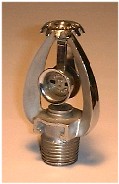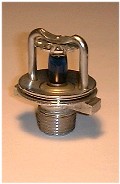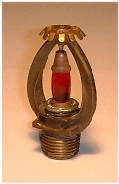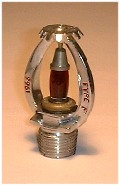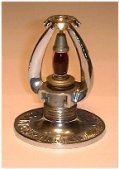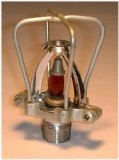Home » Mather + Platt » Fire engineering
Fire Engineering
The primary fire engineering business was the design, manufacture and installation of water sprinkler and gas extinguishing systems, together with their associated pipework, valves, tanks and pumps. Pumps varied from single stage Lynavane pumps to more sophisticated multi-stage pumps. Multi-stage pumps are usually used to provide a very high pressure supply but in the case of sprinkler installations they were used with interstage branches in tall buildings to provide a variety of pressures so that the pressures at each floor were similar. The first stage branch would probably server the ground, first and second floors, the second stage branch floors 3, 4 and 5, and so on. Fire pumps, their bedplates and pipework were usually painted red so that they could be easily distinguished from other feed water services.
 Sprinkler manufacture was undertaken using the Grinnell tradename. The glass sprinkler bulbs were also
manufactured at Park Works. The bulbs were made by blowing glass into two-piece split steel moulds.
The bulbs were filled with coloured amyl acetate, each colour denoting the temperature at which the bulb
would burst and therefore cause the sprinkler to discharge. The bursting temperature is controlled solely
by varying the size of the air bubble in the bulb - low temperature bulbs having a small bubble and high
temperature bulbs having a large bubble. It was of course necessary to ensure that bulbs designed to
burst at a particular temperature did not burst at a lower temperature and so all batches were tested by
submerging in hot oil at just below the bursting temperature. Bulbs which had too small a bubble burst
and were therefore eliminated.
Sprinkler manufacture was undertaken using the Grinnell tradename. The glass sprinkler bulbs were also
manufactured at Park Works. The bulbs were made by blowing glass into two-piece split steel moulds.
The bulbs were filled with coloured amyl acetate, each colour denoting the temperature at which the bulb
would burst and therefore cause the sprinkler to discharge. The bursting temperature is controlled solely
by varying the size of the air bubble in the bulb - low temperature bulbs having a small bubble and high
temperature bulbs having a large bubble. It was of course necessary to ensure that bulbs designed to
burst at a particular temperature did not burst at a lower temperature and so all batches were tested by
submerging in hot oil at just below the bursting temperature. Bulbs which had too small a bubble burst
and were therefore eliminated.
There were alternative means of triggering a discharge, other than simply allowing the temperature to expand the liquid in the bulb and shatter the glass. In certain applications it may be necessary to trigger a number of sprinklers simultaneously so that the fire is contained and extinguished quickly rather than let it spread and trigger sprinklers as it spreads. In these installations, normal sprinklers are used in conjunction with a network of open sprinklers, that is, sprinklers without bulbs. The normal sprinkler is set off by the fire and the flow of water in the pipework triggers a deluge valve which then feeds water to the open sprinklers.
Another method of triggering sprinklers is by electric means. These types of sprinklers have an explosive charge which is fired by an electric pulse. A plunger shatters the bulb when the charge is fired.
The use of bulbs is extended to fusible links which in normal operation keep sliding or rolling shutter doors open. When the bulb shatters, the link breaks and the doors close automatically using gravity. Once again, a variation can be to trigger these by firing an explosive charge with an electric pulse. The brass sprinkler bodies were cast and fettled in the Farnsworth non-ferrous foundry and machined, threaded and assembled at Park Works. Sprinkler bodies which contained casting defects, or whose machining was out of tolerance, were frequently found in the scrap stage where employees salvaged them as keepsakes. As far as official keepsakes were concerned, Mather and Platt manufactured special chromium-plated sprinkler bases, which, when fitted with a similarly plated sprinkler were given to prospective customers as paperweights.
The sprinklers are assembled by placing a valve plate on to the machined seat, followed by a lower end bulb cap, the bulb itself and finally an upper end bulb cap. The entire assembly is held together by a grub screw fitted in the end of the sprinkler. Finally, a lead ball is pressed into the threaded hole after the grub screw to prevent loosening of the grub screw and as a tamper-evident plug.
The range of sprinkler types was extensive. Bare metal sprinklers were used in warehouses, factories and other places where they would be out of public view. Where the sprinklers would be seen however, for example in shops and hotels, smaller chrome-plated versions were used. Wire cages were fitted to sprinklers if they were situated in locations which made them susceptible to being damaged or where they could be struck by people.
The temperature rating of each type of sprinkler bulb is indicated by colour, as follows;
| Orange | X | |||
| Red | X | |||
| Yellow | X | |||
| Green | X | |||
| Blue | X | |||
| Violet | X | |||
| Black | X | |||
| Black | X | |||
Mather and Platt didn't just make fire sprinkler systems. There were also CO2 and Halon gas extinguishing systems and Mulsifyre and Protectospray systems. CO2 was used in unmanned areas because of its asphyxiant properties. Halon in its various forms were used in computer rooms and other areas that were more often occupied than not. Halon is now banned by the Montreal Protocol because of its high impact on ozone depletion and alternatives are now available.
There was also the range of water and CO2 hand-held extinguishers in various types and sizes.

.jpg)
